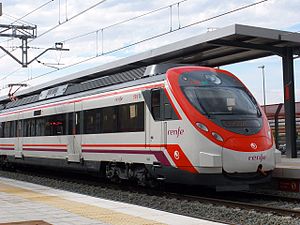| Civia 462, 463, 464 and 465 | |
|---|---|
 Civia 463 EMU at Utebo operating under Cercanías Zaragoza. | |
 The interior of a Civia train of Cercanías Cádiz. | |
| In service | 2003–present |
| Manufacturer | CAF and Siemens |
| Constructed | 2002–2003, 2004–2010 |
| Entered service | 2003 |
| Formation |
|
| Capacity |
|
| Operators | Renfe (2003–2005, 2007–present) |
| Specifications | |
| Car length |
|
| Width | 2,940 mm (9 ft 7.75 in) |
| Height | 4,265 mm (13 ft 11.91 in) |
| Doors | 4 per car |
| Maximum speed | 120 km/h (75 mph) |
| Weight |
|
| Power output |
|
| Electric system(s) | 3 kV DC (nominal) from overhead catenary |
| Current collector(s) | Pantograph |
| Safety system(s) | ASFA, ASFA Digital, ERTMS |
| Track gauge | 1,668 mm (5 ft 5+21⁄32 in) Iberian gauge |
Civia is a class of electric multiple unit trains built by CAF and Siemens for the Renfe Cercanías commuter railway networks in Spain. The first units entered service in 2003.
The Civia train concept was created with passenger comfort and build quality in mind, and to meet the goals of reliability, frequency and punctuality. They have better provision for disabled passengers than older Cercanías trains.
